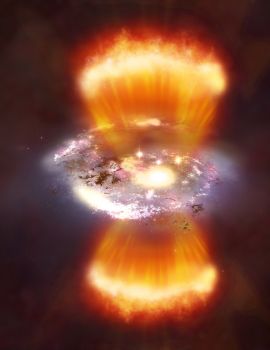Scientists prove stars are born more rapidly than was previously thought
By: James Hakner
Last updated: Monday, 20 December 2010

starburst
Scientists, including astronomers at Sussex, have presented the first conclusive evidence that stars formed most rapidly about 10 billion years ago, or about three to four billion years after the Big Bang, and that the rate of star formation is much faster than was thought.
Using the European Space Agency's Herschel Space Observatory to study distant objects with the Spectral and Photometric Imaging Receiver (SPIRE) camera, researchers have discovered that galaxies are forming stars at a tremendous rate and have large reservoirs of gas that will power the star formation for hundreds of millions of years.
The data from Herschel and SPIRE is helping to produce a map of the universe as it was around eight billion years ago. The map project, HerMES (Herschel Multi-tiered Extragalactic Survey), is led by Professor Seb Oliver at Sussex. He said: "We are really blown away by the tremendous capability of Herschel to probe the distant universe. This work gives us a real handle on how the cosmos looked early in its life."
His colleague, Dr Isaac Roseboom, said: "It was amazing and surprising to see the Herschel-SPIRE observations uncover such a dramatic population of previously unseen galaxies".
The key to the new results is the recent discovery of a new type of extremely luminous galaxy in the early Universe. These galaxies are very faint in visible light, as the newly-formed stars are still cocooned in the clouds of gas and dust within which they were born. This cosmic dust, which has a temperature of around -232 degrees C, is much brighter at the longer, far infrared wavelengths observed by the Herschel satellite.
Herschel is the first telescope with the capability to detect these galaxies at the peak of their output. With these Herschel observations, focused on around 70 galaxies in the constellation of Ursa Major, the scientists acquired the missing piece of evidence to confirm that these galaxies represent a crucial episode in the build-up of large galaxies around us today, such as our own Milky Way.
This result was one of a number published in a special edition of the journal Monthly Notices of the Royal Astronomical Society focusing on results from Herschel. The special edition was the brain child of Professor Oliver and included 17 Herschel papers including 12 from his team.

